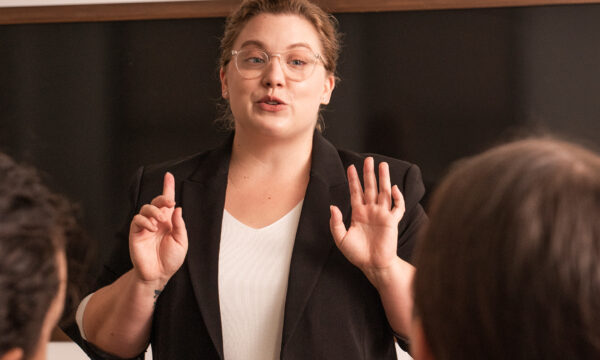
Shop This Look
Please Take Your PTO
Letting your vacation days go to waste may actually be hurting your career. Here’s why.
Want more M Dash?
Sign up for our weekly newsletter.
Thank you!
Zoe Namerow, a marketing communications leader, has long had a bad habit of leaving paid time off on the table. And once the Covid-19 pandemic hit, she used even fewer PTO days than before. “We already had so much flexibility,” she explains. “And there was nowhere to go and nothing to do.”
PTO habits—and policies—vary widely depending on industry, company size and culture, and seniority, but one thing is clear: Americans value paid time off, but they aren’t taking enough of it. And things did get worse after the pandemic: In 2022, 55% of PTO went unused compared to 28% in 2019.
“When managers don’t take PTO, their direct reports don’t either.”
Alex Alonso, Chief Knowledge Officer at the Society for Human Resource Management (SHRM), says that every Chief Human Resource Officer he speaks to is concerned about PTO and burnout. And with good reason. According to recent data from the Pew Research Center, 62% of workers say it’s “extremely important” to them to have a job that offers paid time off, and another 27% say it’s “very important.” But more than four in ten workers who get PTO take fewer days than their employers give them, which puts them at risk for burnout.
So what’s happening? Jen Dary, a leadership coach and the founder of Plucky, explains that the current state of PTO is, in large part, a product of the recent economic downturn. “It’s all hands on deck,” she explains. “This is not the generous culture of Covid, where people are like, ‘Oh my gosh, be with your families. That’s what’s really important,’” says Dary. “Now it’s sort of like, ‘We really, really don’t want to do another round of layoffs. So we really, really still need to meet these deadlines.’”
Both Dary and Alonso say it’s the 12 million people managers in the U.S. who are feeling the squeeze.

The Role of Managers
In 2023, too many managers are stuck filling in the gaps for people who aren’t on the job, whether that’s because of “workforce reductions” or PTO.
“These middle managers are trying to execute on decisions made in conference rooms they were not in,” says Dary. “And they also need to retain people and keep them productive.” So they’re stuck between a rock and a hard place. They want to empower their direct reports to take PTO, so they delay or forfeit their own PTO to cover for their team.”
But that can backfire, because when managers don’t take PTO, their direct reports don’t either. So when Dary works with managers who are feeling the squeeze, she focuses on two things. First, the short term. “Would taking a day off ASAP help? Would it help to take your longer vacation in June instead of August?” she asks clients. “If you’re getting close to burnout or overwhelm, let’s get a couple things on the calendar so you have that to look forward to.”
“The more PTO an employee took, the more engaged they were.”
Next, she turns her focus to the medium term. “Yes, you need to take care of yourself. But you’re also responsible for your team’s performance,” she explains. “So you have to ask, ‘How might my team be able to do our best work in Q4?’” That may mean helping them think more creatively to prevent burnout, attrition, and—ultimately—layoffs.
Alonso says there’s something else going on here, too. Managers, who are already concerned about their lack of visibility in a hybrid world, have a fear of missing out on a big opportunity, a sort of leadership FOMO that keeps them tied to their desks.
What Can Companies Do?
“HR professionals are looking for new and novel ways to encourage their workforces to use all of their PTO,” says Alonso. An important first step, he says, is to disabuse people of the concept of work emergencies. Nothing, he says—not even curing cancer—is so important that people shouldn’t be able to take a break.
Of course, cultural shifts take time, and some companies have no time to waste. Alonso tells the story of Chipotle’s corporate office, which saw a link between PTO and engagement. “The more PTO an employee took, the more engaged they were,” he explains. “So they actually started to build in mandatory PTO three days a month.”
“I love my company, but ultimately, PTO is part of my compensation. It’s a transactional relationship, and if they’re going to give me days, I’m going to take them.”
Other companies are incentivizing PTO by asking employees to report out on how they recharged and rested while on vacation and then rewarding them with movie tickets, dinner out, or some other fun prize when they do.
And if taking a week or two of vacation all at once feels impossible or even just impractical, companies can encourage people to spread out their PTO. Alonso says he sees more and more people taking off a series of Fridays so they can work four-day weeks for a while.

Protect Your PTO
Ultimately, no one else can use your PTO. Here’s how to make the most of it:
Let go of the guilt
“I started my career in a very deadline-driven environment,” says Namerow, explaining why she’s always had a lot of guilt about “abandoning” her colleagues to meet deadlines without her. “It didn’t ever feel like the right time for a vacation.”
But her partner, Rowan Jones, a superintendent for a construction management firm, “empties the bank” every year—meaning she maxes out her PTO—and reminds Namerow that work is a contract. “I love my company,” Jones says, “but ultimately, PTO is part of my compensation. It’s a transactional relationship, and if they’re going to give me days, I’m going to take them.”
Get comped
When your company asks more of you, ask more of them. Jones recently had to work or be on call 24/7 for 28 days straight because a big project wasn’t properly staffed and a deadline loomed. She agreed because she wanted to do right by the client, but she also requested an extra week of PTO to compensate. “I hated the fact that I had to work that whole month,” she says, “but the fact that they were respectful and gave me comp time and no one bothered me? That was actually huge.”
Try breaking up big chunks of PTO
Dary, who owns her own business, used to take off an entire month during the summer—“which sounds really fresh on paper”—but it wasn’t working: It was depressing instead of relaxing. This summer, she’s making most weekends a five-day weekend instead.
Overcommunicate
Block your calendar early. Send a “PTO invite” to everyone you collaborate with regularly so it’s on their calendars, too. And add upcoming PTO dates to your Slack status and your email signature a couple of weeks in advance to remind people you’ll be unavailable.
Create an OOO document
This is Namerow’s secret weapon. Before she sets her Slack status to “away,” she creates and widely circulates a Google doc that captures all of her work in progress. “I include links to working documents, names of teammates who will jump in or need visibility, action items, and due dates,” she explains. “If a project includes anyone external, like an agency or vendor, I include their contact information and make introductions before leaving the office. I also always double or triple-check that everyone has edit access to all the documents.”
Enforce boundaries that work for you
Dary suggests that some clients delete Slack, Outlook, and other work-related apps from their phone so they can truly be out of the office.
Jones, who has a separate work phone, goes dark when she’s on PTO. “I look at my ability to walk away—not to have to take calls and answer messages—as a sign that I’m doing my job well, and I’ve set my team up for success,” she explains. “I mean, if a project is dead in the water because I’m not there, something’s wrong with my team.”
Namerow, on the other hand, finds not knowing what’s happening in her absence more stressful than knowing. “I’d rather be aware: Okay, there is a little fire I’ll have to deal with when I get back,” she explains. So she spends a few minutes each day looking at email and Slack without officially logging on. “At least then I’m prepared. And then I can relax.”











